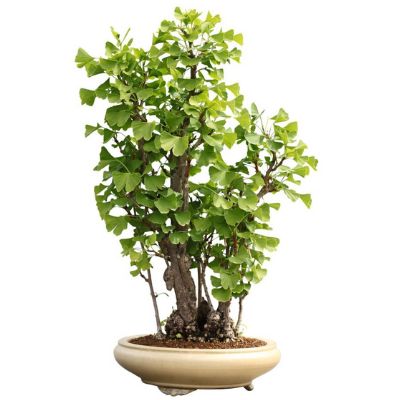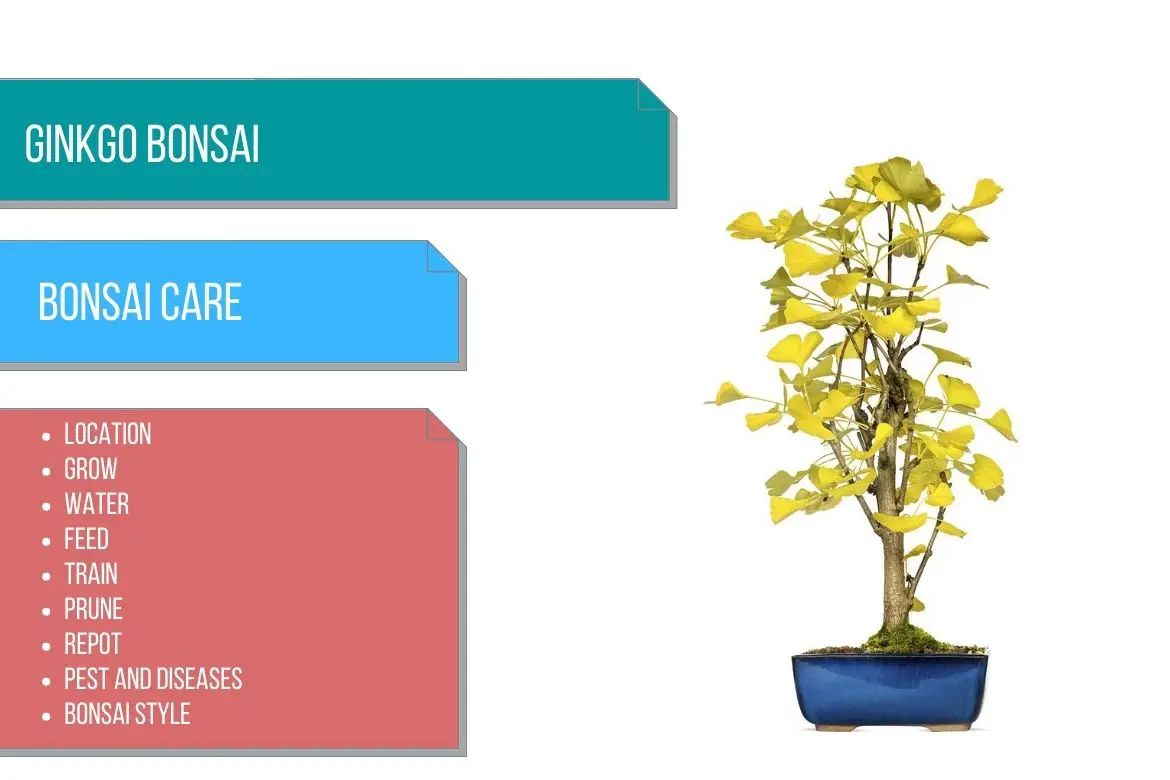
Ginkgo / Maidenhair tree
(Ginkgo biloba)
Country of Origin : Japan and China
Bonsai Styles : Informal upright, twin trunk, broom
Zone : 5 – 9
Ginkgo biloba, aka ginkgo or Maidenhair tree or Icho, is regarded as one of the oldest trees to have survived from ancient times.
Until its rediscovery in China in the seventeenth century, this species was thought extinct.
In China and Japan, this species is highly prized for bonsai due to its beautiful leaves, which turn yellow in fall, and due to its long life.
A primitive form of conifer, its leaves are fan-shaped, like those of the maidenhair fern.
With time, the branches and trunks of the tree become more gnarled, but never develop a refined structure.
The female and male flowers grow on separate ginkgo trees.
The male flowers resemble catkins, while the female flowers are round and produce plum-like fruits.
In nature, ginkgo trees grow in a flame shape. Hence, most of them are trained in that shape when making a bonsai.
Important : There is a tendency for ginkgos to grow vigorously one year and barely at all the next. During winter, some shoots are also aborted, making wire training futile. Therefore, ginkgo bonsai trees are generally grown for their yellow fall color rather than for their shape or bonsai style.
Best location to keep Ginkgo Bonsai
Ginkgo biloba bonsai tree thrives in full sun or partial shade.
Despite their tolerance of full sun, young shoots may be scorched by direct sun in midsummer, so they benefit from partial shade.
The sun improves fall color, but if the soil dries out due to evaporation, the tree will respond by dropping its shoots and branches.
To prevent this, you can keep the bonsai tree in shade. However, the growth of the tree will be slow and the size of the leaves will increase.
You might find yourself changing the location of the bonsai tree quite often before you find a perfect spot for the ginkgo bonsai tree.
Protect the tree from frost, especially the roots. In the coldest months, you can keep the bonsai pot in an insulated shed.
Site in full sun, or slight shade for young trees. Protect from frost, especially the roots.
Ginkgo bonsai tree can survive in a temperature range between 30 to 90 °F (-1 to 32°C).
Refer sunlight requirements for indoor plants for more indoor gardening ideas. Also, refer to do bonsai trees need sunlight for more indoor and outdoor bonsai location ideas.
Propagation of Ginkgo
Ginkgo tree can be propagated by air layering in spring.
It can also be propagated by using seeds. Stratify the seeds in fall and sow these seeds in early spring.
Also, it can be propagated using hardwood cuttings in fall.
Watering Ginkgo Bonsai
Water the ginkgo bonsai tree generously throughout the growing season, especially in hot days in summer.
In winters keep the bonsai soil just moist. However, you can also keep the soil to a little drier side in coldest days in winter. Because too much moisture can lead to damaging of roots due to frost.
In summer, misting will be beneficial to foliage.
Wiring Ginkgo Bonsai
Ginkgo bonsai trees do not usually require wiring since they are grown in ‘flame shapes‘ or ‘columnar silhouette‘, which is the natural growing habit of this species.
If possible, avoid wiring, as the bark tends to mark easily.
Pruning Ginkgo Bonsai
When to prune Ginkgo bonsai?
How to prune Ginkgo bonsai?
Important : Ginkgo trees dislike being pruned, and pruned shoots will die back more, either immediately after pruning or, more frustratingly, during the winter.
As a result, the trunk of the tree develops a heavy taper and a few short, upward-facing branches. However, not all shoots will die back, and the ones that survive are used for branch building.
Pruning of old wood and dead material should be done in early spring, before new leaves sprout.
During the growing season, prune new growth twice, once in spring and once in fall.
Be aware that constant pruning can encourage suckers to proliferate.
New shoots should be pruned to shape as needed. Leaves should be pruned so they face the direction of growth.
Prune back the shoot to two or three leaves, with the topmost leaf on the outside. Prune back branches after leaf fall.
You need to remember that the wounds on ginkgo don’t heal over like they do with almost every other species. Pruning carelessly can leave ugly wounds that do not heal. So avoid large cuts to be safe.
Avoid damaging the bark around the wound. Leave small stubs and trim them carefully a year later, after they have dried.
In case you have repotted the bonsai tree, prune after waiting for at least 3-4 weeks.
Pinching Ginkgo Bonsai
During the growing season, pinch out the growing tips of new shoots on the trunk and main branches when two or three true leaves have formed on each shoot.
Repotting Ginkgo Bonsai
When to repot Ginkgo bonsai?
Ginkgo bonsai tree can be repotted every year in early spring or late winter.
After the tree has matured (almost 10 years old), you can start repotting the bonsai tree every 2-3 years.
While repotting the tree, avoid using any tool which can crush the fleshy roots of the tree.
After repotting, protect from frost until new growth begins.
You can use a basic soil mix.
OR
Use a mix of 70% organic matter and 30% grit.
OR
You can also use a bonsai soil which is a mix of sand, peat and loam in the ratio of 1:1:2.
Must Read: Bonsai Soil Recipes
Must read : Choosing the right bonsai container
Feeding Ginkgo Bonsai
Apply a general fertilizer from spring to summer.
Use a nitrogen-free or low-nitrogen feed for the last fall feed.
Diseases and pest of Ginkgo Bonsai
Even though these trees are relatively trouble-free, aphids are often drawn to the new leaves of these trees. Apply a systemic insecticide if there are too many to remove by hand.
Ginkgo bonsai care
The roots of ginkgo trees are thick, fleshy, and can hold a lot of moisture. If the roots become frozen, the water expands and the roots can literally explode under the pressure, particularly if the water content of the roots and the soil is out of balance.
Hence, protect the ginkgo bonsai tree from prolonged or severe freezing conditions.
Pruning often results in the shoots dying back, sometimes all the way back to the parent branch.
Leave a short stub and seal it as soon as possible to minimize die-back.
Ginkgo trees don’t grow too much some years, so don’t be too concerned. It is common for them to grow very little one year and bolt the next.
What to look for when buying Ginkgo Bonsai
Creating a bonsai ginkgo takes time, as evidenced by the high price of a ginkgo bonsai specimen. Japan, however, exports plants of sufficient size for reasonable prices.
These trees are usually field grown and then planted in a deep bonsai container for about one or two years. Although they are not fully-developed bonsai, they can provide you with a good starting point.
Typically (when you buy a young tree), the existing twigs will die back or be replaced. Therefore, it is critical to pick a ginkgo bonsai tree specimen with an appealing trunk, a good root system, and at least a few short, established branches.
Few patches of dieback are normal and do not necessarily indicate health problems in the ginkgo bonsai tree.

